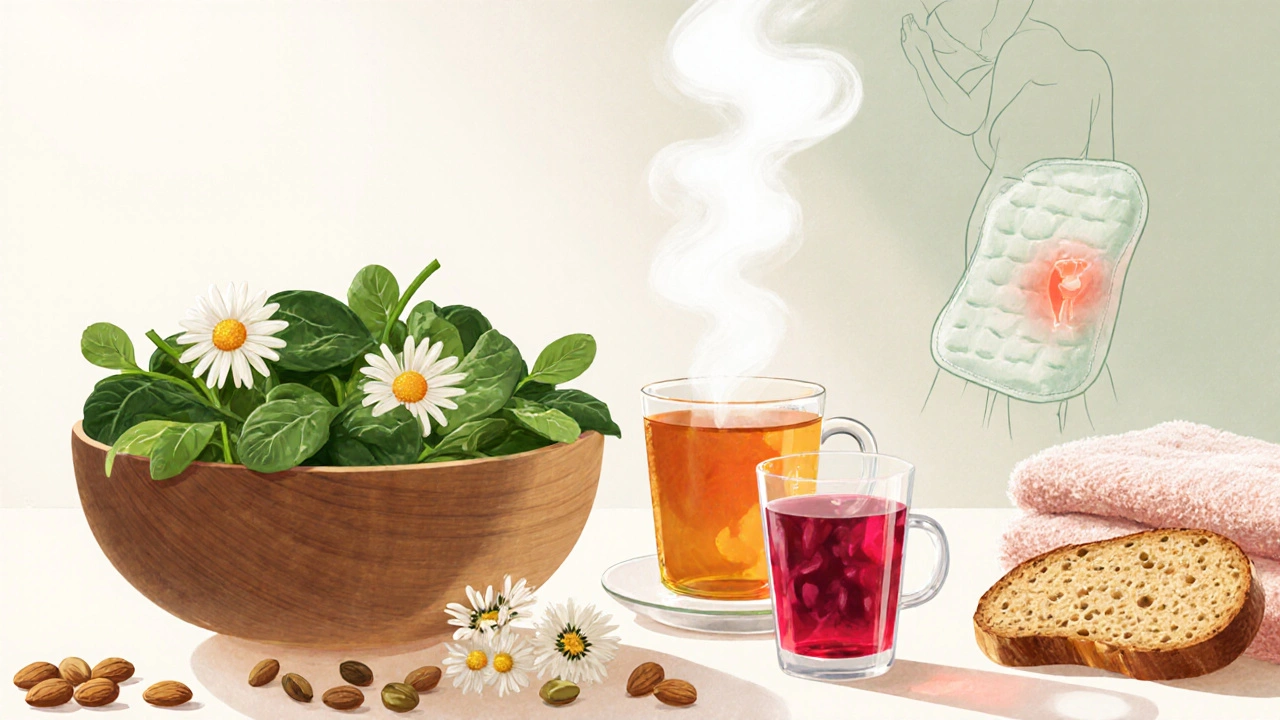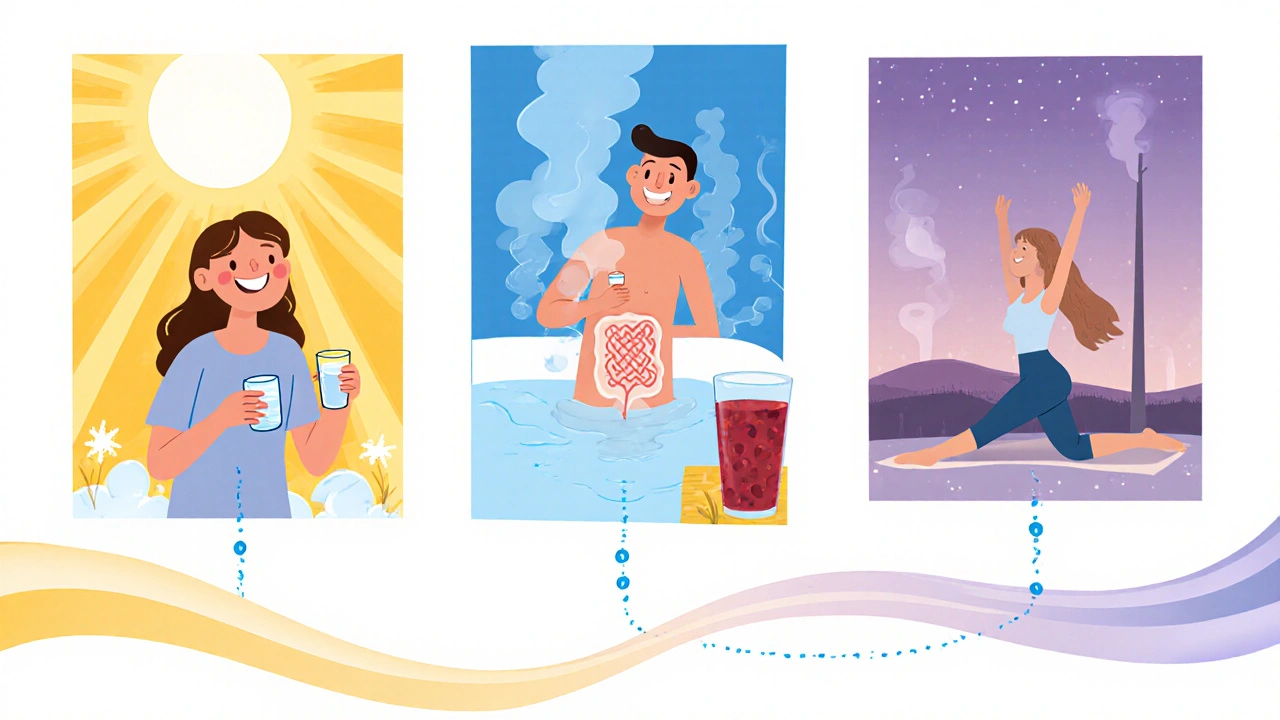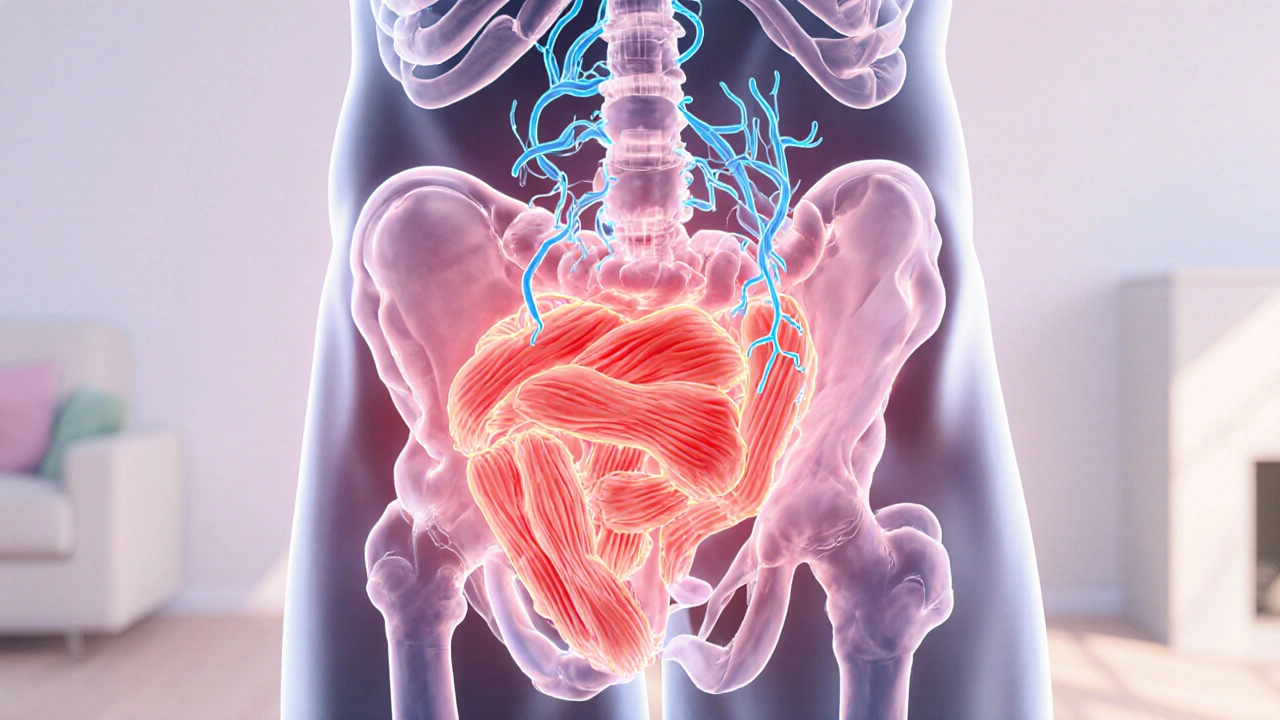Personalized Remedy Finder
Discover which home remedies are most effective for your specific bladder spasm triggers. Answer a few questions to receive a personalized daily plan.
Identify Your Triggers
Check all that apply to you
Your Personalized Remedy Plan
Dealing with sudden, painful contractions in the bladder or the rest of the urinary tract can feel like a surprise attack from your own body. The good news? You don’t always need a prescription to find relief. Below you’ll discover easy‑to‑apply home strategies that target the root causes of bladder muscle spasms and help you get back to a comfortable routine.
Key Takeaways
- Identify common triggers such as dehydration, caffeine, and stress.
- Try magnesium‑rich foods or supplements to calm muscle activity.
- Use heat therapy and gentle pelvic floor exercises to improve blood flow and muscle control.
- Incorporate herbal teas and cranberry juice for soothing anti‑inflammatory effects.
- Seek professional help if spasms persist beyond a few weeks or are accompanied by fever.
What Exactly Are Bladder Muscle Spasms?
When the smooth muscle in the bladder wall contracts unintentionally, you feel urgency, burning, or a sharp cramp. In medical terms, this is known as:
Bladder muscle spasms are involuntary, painful contractions of the detrusor muscle that line the bladder, often causing a sudden urge to urinate and discomfort.These spasms can also occur along the ureters and urethra, which we collectively refer to as:
Urinary tract muscle spasms involve the muscular walls of the ureters, bladder, and urethra, leading to similar urgency and pain sensations.Both conditions share underlying mechanisms: over‑active smooth muscle, heightened nerve signals, or irritation from infection or stones.
Common Triggers You Might Not Expect
- Caffeine and alcohol: Both act as diuretics and irritants, prompting the bladder to contract more often.
- Dehydration: Concentrated urine can irritate the lining, triggering reflex spasms.
- Stress: Anxiety spikes adrenaline, which can increase smooth‑muscle tone.
- Spicy or acidic foods: They may inflame the urinary tract lining in sensitive individuals.
- Holding urine too long: Stretching the bladder can lead to hyper‑responsiveness.
Knowing your personal triggers is the first step toward preventing spasms.
Home Remedy #1: Magnesium - The Natural Muscle Relaxant
Magnesium plays a crucial role in nerve transmission and muscle relaxation. Low levels are linked to increased smooth‑muscle excitability, which can fuel spasms.
Magnesium is a vital mineral that helps regulate muscle contraction, nerve signals, and electrolyte balance.- Dietary sources: Leafy greens (spinach, kale), nuts (almonds, cashews), seeds (pumpkin, chia), and whole grains.
- Supplementation: Magnesium citrate or glycinate are well‑absorbed forms. Start with 200‑300mg daily, split between morning and evening.
- Safety tip: Excessive magnesium can cause diarrhea. If that happens, lower the dose or switch to a glycinate form.
Most people notice a reduction in urgency after a week of consistent magnesium intake.
Home Remedy #2: Heat Therapy - Warmth That Relaxes
Applying gentle heat to the lower abdomen increases blood flow, eases muscle tension, and can diminish spasm frequency.
Heat therapy involves applying mild warmth (via heating pads or warm baths) to relax smooth muscle and reduce pain.- How to use: Place a low‑setting heating pad on the suprapubic area for 15‑20minutes, two to three times daily.
- Warm bath: Soak for 20minutes; adding Epsom salts (magnesium sulfate) amplifies the benefit.
- Safety: Avoid temperatures above 45°C (113°F) to prevent skin burns.

Home Remedy #3: Herbal Teas That Calm Irritation
Some herbs have mild antispasmodic and anti‑inflammatory properties that soothe the urinary lining.
Herbal tea refers to a brewed infusion of plant leaves, stems, or roots, often used for therapeutic effects.- Chamomile: Contains apigenin, which relaxes smooth muscle. Drink 1‑2 cups daily.
- Marshmallow root: Forms a protective mucilage, reducing irritation. Steep 1‑2 teaspoons in hot water for 10 minutes.
- Parsley leaf: Mild diuretic that helps flush irritants. Use sparingly-1 cup per day.
Switch up the teas to keep the routine enjoyable.
Home Remedy #4: Pelvic Floor Exercises - Strengthen, Don’t Over‑Activate
Targeted exercises improve muscle coordination, helping the bladder contract only when you want it to.
Pelvic floor exercises are a set of contractions and relaxations of the muscles that support the bladder, uterus, and bowel.- Locate the muscles by stopping urine mid‑stream (do this only for learning, not during regular voiding).
- Contract the muscles for a count of 5 seconds, then relax for 5 seconds.
- Repeat 10 times, three times a day.
- Progress to longer holds (up to 10 seconds) as strength improves.
Consistency matters more than intensity. Most users feel fewer urgency episodes after two weeks.
Home Remedy #5: Cranberry Juice - A Gentle Antiseptic
While cranberry isn’t a cure‑all, its pro‑anthocyanidins prevent bacteria from sticking to the urinary tract lining, reducing infection‑related spasms.
Cranberry juice is a tart beverage rich in antioxidants that can inhibit bacterial adhesion in the urinary tract.- Choose 100% pure, unsweetened juice to avoid added sugars that could worsen inflammation.
- Dosage: 8‑12oz (about 240‑360ml) once daily.
- Tip: If the taste is too sharp, dilute with sparkling water and a splash of lime.
For people prone to UTIs, regular cranberry intake can lower the chance of infection‑triggered spasms.
Home Remedy #6: Acupuncture - An Alternative Worth Trying
Acupuncture can modulate the nervous system, reducing hyper‑reactivity of the bladder’s nerves.
Acupuncture is a traditional Chinese medical technique that involves inserting thin needles at specific points to balance energy and alleviate pain.- Typical course: 6‑8 sessions, once or twice weekly.
- What to expect: A mild tingling sensation; most people report decreased urgency within a month.
- Safety: Ensure the practitioner is licensed and uses sterile needles.
While scientific evidence is mixed, many patients share positive anecdotal results.

When Home Care Isn’t Enough - Signs to See a Doctor
Natural methods are great, but they shouldn’t replace professional assessment when warning signs appear.
- Fever, chills, or cloudy urine - could signal a urinary infection.
- Blood in the urine (hematuria) - may indicate stones or more serious conditions.
- Pain that worsens or lasts more than two weeks despite home treatment.
- Difficulty emptying the bladder completely (post‑void residual).
If any of these symptoms show up, schedule a telehealth visit or see a urologist. Early diagnosis can prevent complications.
Quick Comparison: Home Remedies vs Over‑the‑Counter Medications
| Category | Typical Use | Onset of Relief | Side‑Effect Risk | Average Cost (AU$) |
|---|---|---|---|---|
| Magnesium supplement | Daily mineral support | 5‑7 days | Low (diarrhea if excess) | 10‑20 |
| Heat therapy (pad/bath) | 2‑3 times per day | Immediate to 30min | 5‑15 (electric pad) | |
| OTC antispasmodic (e.g., Oxybutynin) | Prescription‑free tablets | 1‑2 days | Medium (dry mouth, constipation) | 25‑35 |
| Herbal teas | 1‑2 cups daily | 2‑3 days | Very low | 3‑8 |
| Cranberry juice | Preventive, 8‑12oz daily | 1‑2 weeks (infection‑related spasms) | Low (possible stomach upset) | 6‑12 |
Putting It All Together - A Simple Daily Plan
- Morning: Take 200mg magnesium citrate with water.
- Breakfast: Drink a cup of unsweetened cranberry juice.
- Mid‑morning: Warm bath or 15‑minute heating pad session.
- Lunch: Sip chamomile tea and perform three sets of pelvic floor exercises.
- Afternoon: Hydrate with water; avoid caffeine.
- Evening: Warm herbal tea (marshmallow root) and a second heating pad session if needed.
- Before bed: Gentle stretching, deep‑breathing to lower stress.
Adjust each step based on how your body feels. Consistency beats occasional intensity.
Frequently Asked Questions
Can I use magnesium if I have kidney disease?
People with significant kidney impairment should talk to a doctor before supplementing, because excess magnesium can build up in the blood.
How long should I keep a heating pad on my lower abdomen?
Limit each session to 15‑20minutes and give the skin at least an hour to rest before the next use.
Is it safe to drink cranberry juice every day?
Yes, as long as it’s unsweetened and you stay within 8‑12oz per day. Too much can irritate the stomach in some people.
Do pelvic floor exercises help with urgency?
They strengthen the muscles that control bladder emptying, which often reduces sudden urges after a few weeks of regular practice.
When should I see a urologist for spasms?
If you experience fever, blood in urine, pain lasting more than two weeks, or failure to improve with home care, schedule a professional evaluation.



Okay, let me just pour my heart out about how unbelievably frustrating those bladder spasms can be, because honestly, it feels like your insides decided to throw a surprise rave and didn’t even send you an invitation. I’ve been there, curled up on the couch at 2 a.m., heart racing, trying to figure out whether I should get up for the bathroom or just surrender to the panic. The way the article lists magnesium and heat therapy is nice, but let me tell you, the real battle is in the moments when you’re stuck at work, suddenly jolted by a cramp that makes you look for the nearest restroom like a deer in headlights. Dehydration? Sure, we’ve all heard that, but when you’re juggling kids, deadlines, and a coffee habit that borders on an addiction, it’s hard to remember to drink water. And caffeine-oh, the sweet, sweet devil that keeps us awake but also keeps the bladder on overdrive. I’ve tried those herbal teas, and while the chamomile is pleasant, the taste of marshmallow root makes me feel like I’m sipping a medieval potion. Heat pads are a godsend, but my landlord keeps warning me about fire hazards every time I plug one in, so I’m stuck with a damp towel that barely makes a dent. Pelvic floor exercises? I can barely remember to breathe properly during yoga, let alone contract muscles on cue in the middle of a meeting. The article’s “simple daily plan” sounds brilliant, but life is messy, and sometimes the best we can do is panic‑manage a few symptoms while hoping they don’t turn into a full‑blown infection. I’ve also read that some people with kidney issues shouldn’t take magnesium... that scares me, because I have a family history of kidney stones and now I’m worrying about the next supplement I pick up at the pharmacy. And let’s not forget that stress-it’s like an invisible puppeteer pulling strings on every muscle, including the detrusor, making everything feel ten times worse. We all want quick fixes, but the truth is, consistency is a cruel teacher who shows up at 6 am with a reminder that you missed your water intake yesterday. So, dear strangers, if you’re feeling like your bladder has declared independence, know that you’re not alone, and maybe, just maybe, a combination of the tips here-magnesium, a warm bath, a dash of chamomile, and a solid breathing routine-can become a lifeline rather than a list of chores. And if all else fails, remember that a doctor’s appointment is not a sign of weakness, but a sign that you finally gave your body the respect it deserves. Keep fighting, because your comfort matters, even if it feels like the universe is conspiring against you.